GI-tract Study guides, Class notes & Summaries
Looking for the best study guides, study notes and summaries about GI-tract? On this page you'll find 11988 study documents about GI-tract.
Page 2 out of 11.988 results
Sort by
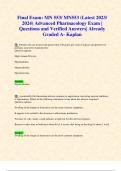
-
Final Exam: MN 553/ MN553 (Latest 2023/ 2024) Advanced Pharmacology Exam | Questions and Verified Answers| Already Graded A- Kaplan
- Exam (elaborations) • 41 pages • 2023
-
Available in package deal
-
- $11.49
- 1x sold
- + learn more
Final Exam: MN 553/ MN553 (Latest 2023/ 2024) Advanced Pharmacology Exam | Questions and Verified Answers| Already Graded A- Kaplan Q: Patients who are treated with greater than 100 grams per week of topical calcipotriene for psoriasis need to be monitored for: Question options: High vitamin D levels Hyperkalemia Hypercalcemia Hyperuricemia Answer: Hypercalcemia Q: A potentially life-threatening adverse response to angiotensin-converting enzyme inhibitors is angioed...

-
NURS 251 Pharmacology Final Exam-Portage Learning
- Exam (elaborations) • 17 pages • 2022
-
- $15.49
- 42x sold
- + learn more
NURS 251 Pharmacology Final Exam-Portage Learning 1 1. Sublingual: When rapid effect is needed right away Subcutaneous: Destroy or inactivated in the GI Tract Intramuscular: Used for drugs with poor oral absorption Topical: For local effects on skin and eyes Pharmaceutics is the study of how various dosage forms influence the way in which the drug affects the body/ Administration of dosage form, dissolution of drug into body/ manipulating chemical compound. Pharmacokinetics is the st...
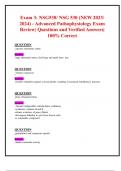
-
Exam 3: NSG530/ NSG 530 (NEW 2023/ 2024) - Advanced Pathophysiology Exam Review| Questions and Verified Answers| 100% Correct
- Exam (elaborations) • 52 pages • 2023
-
Available in package deal
-
- $11.49
- 1x sold
- + learn more
Exam 3: NSG530/ NSG 530 (NEW 2023/ 2024) - Advanced Pathophysiology Exam Review| Questions and Verified Answers| 100% Correct QUESTION superior mesenteric artery large abdominal artery; feed large and small intes- tine QUESTION Valsalva maneuver Answer: forcible exhalation against a closed glottis, resulting in increased intrathoracic pressure QUESTION Role of bacterial flora Answer: -ferment undigestible carbohydrates (cellulose) -synthesize vitamins ...
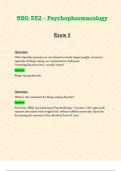
-
NSG552 / NSG 552 Exam 2 (Latest 2024 / 2025): Psychopharmacology | Grade A Questions and Verified Answers | 100% Correct - Wilkes
- Exam (elaborations) • 35 pages • 2024
- Available in package deal
-
- $7.99
- 1x sold
- + learn more
Exam 2: NSG552 / NSG 552 (Latest 2024 / 2025) Psychopharmacology Exam | Grade A Questions and Verified Answers | 100% Correct - Wilkes Q: What disorder presents as: not fixated on body shape/weight, recur- rent episodes of binge eating, no compensatory behaviors (vomiting/laxa- tives/etc), usually obese? Answer: Binge-eating disorder Q: What is the treatment for binge-eating disorder? Answer: First-line: SSRIs (escitalo- pram); Psychotherapy; Vyvanse= FDA approved/ topamx associated with weight ...
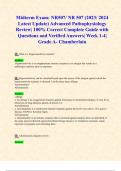
-
Midterm Exam: NR507/ NR 507 (2023/ 2024 Latest Update) Advanced Pathophysiology Review| 100% Correct Complete Guide with Questions and Verified Answers| Week 1-4| Grade A- Chamberlain
- Exam (elaborations) • 93 pages • 2023
-
Available in package deal
-
- $11.99
- 1x sold
- + learn more
Midterm Exam: NR507/ NR 507 (2023/ 2024 Latest Update) Advanced Pathophysiology Review| 100% Correct Complete Guide with Questions and Verified Answers| Week 1-4| Grade A- Chamberlain Q: What is a Hypersensitivity reaction? Answer: Hypersensitivity is an inappropriate immune response to an antigen that results in a pathologic response upon re-exposure. Q: Hypersensitivity can be classified based upon the source of the antigen against which the hypersensitivity response is directe...
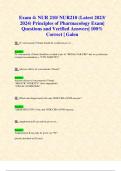
-
Exam 4: NUR 210/ NUR210 (Latest 2023/ 2024) Principles of Pharmacology Exam| Questions and Verified Answers| 100% Correct | Galen
- Exam (elaborations) • 14 pages • 2023
-
Available in package deal
-
- $10.49
- 1x sold
- + learn more
Exam 4: NUR 210/ NUR210 (Latest 2023/ 2024) Principles of Pharmacology Exam| Questions and Verified Answers| 100% Correct | Galen Q: IV voriconazole (Vfend) should be avoided in pts w/ ... Answer: IV voriconazole (Vfend) should be avoided in pts w/ *RENAL FAILURE* due to cyclodextrin excipient accumulation + *CNS TOXICITY*. Q: Adverse effects of voriconazole (Vfend)? Answer: Adverse effects of voriconazole (Vfend): *HEPATIC TOXICITY* (dose-dependent)/ *VISUAL SYMPTOMS*. ...
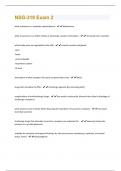
-
NSG-318 Exam 2 Questions and Answers Solved Correctly
- Exam (elaborations) • 28 pages • 2023
- Available in package deal
-
- $12.29
- 2x sold
- + learn more
what substance is a synthetic catecholamine - dobutamine what occurrence is an effect of beta-1 adrenergic receptor stimulation - increased renin secretion which body parts are regulated by the ANS - smooth muscles and glands -eyes -heart -urinary bladder -respiratory system -GI tract stimulation of what receptor will cause increased heart rate - Beta 1 drugs that stimulate the PNS - cholinergic agonists (by mimicking ACH) complications of anticholinergic drugs - dry mouth, tachycardia...
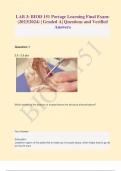
-
LAB 3: BIOD 151 Portage Learning Final Exam: (2023/2024) | Graded A| Questions and Verified Answers
- Exam (elaborations) • 19 pages • 2023
-
Available in package deal
-
- $9.49
- 2x sold
- + learn more
LAB 3: BIOD 151 Portage Learning Final Exam: (2023/2024) | Graded A| Questions and Verified Answers Question 1 2.5 / 2.5 pts Which portion of the pharynx is located above the structure pictured above? Your Answer: Soft pallet - posterior region of the pallet that is made up of muscle tissue, which helps food to go down the GI tract. The nasopharynx is located above the soft palate which is pictured above. ...
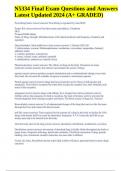
-
N5334 Final Exam Questions and Answers Latest Updated 2024 (GRADED)
- Exam (elaborations) • 25 pages • 2024
-
- $15.49
- 2x sold
- + learn more
N5334 Final Exam Questions and Answers Latest Updated 2024 (GRADED) Prescribing basics correct answers Prescribing is regulated by state BON Proper RX correct answers Providers name and address, Telephone DEA Pt name/DOB/Addres Name of Drug, strength, SIG(directions) with indication/Route and frequency, Quantity and signature. Drug Schedules: Most addictive to least correct answers 1: Heroin,LSD, MJ 2: hydrocodone, cocaine, Methamphetamine, methadone, oxycodone, meperidine, fentanyl, add...
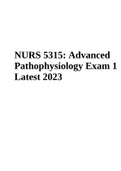
-
NURS 5315: Advanced Pathophysiology Exam 1 Latest 2023
- Exam (elaborations) • 25 pages • 2023
-
Available in package deal
-
- $16.49
- 5x sold
- + learn more
NURS 5315: Advanced Pathophysiology Exam 1 Latest 2023. cells increase in number, mitosis (cell division) must occur, size of cell does not change Phys: increased rate of division, increase in tissue mass after damage or partial resection; may be compensatory, hormonal, or pathologic Patho: abnormal proliferation of normal cells usually caused by increased hormonal stimulation (endometrial). increase of production of local growth factors Ex: removal of part of the liver lead to hyperplasia...

Do you wonder why so many students wear nice clothes, have money to spare and enjoy tons of free time? Well, they sell on Stuvia! Imagine your study notes being downloaded a dozen times for $15 each. Every. Single. Day. Discover all about earning on Stuvia


